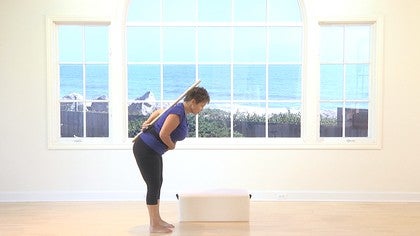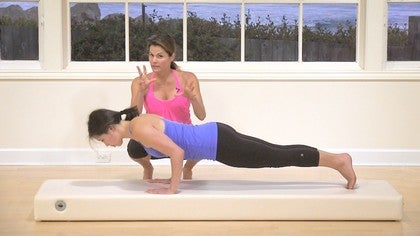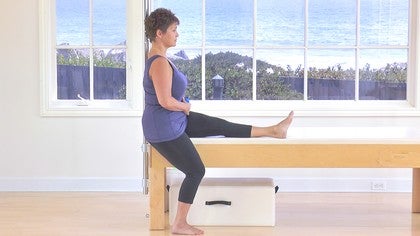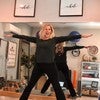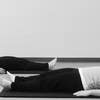Description
About This Video
Transcript
Read Full Transcript
Sometimes I have a hard time differentiating between a hinged spine and a rounded spine. If people don't really have tight hamstrings, they can kind of hinge their spine and hang into their legs. That looks a little bit like this. I don't particularly have tight hamstrings, so that looks a little bit like this just hanging into my legs. But what I want to show you today is with the pole behind your back and you using your own hands, you recognize where the head position is and where the buttocks position is. So normally we have a little curve behind the cervical spine and you have a little space behind the lumbar spine.
So if I separate my legs a little bit and I start to hinge forward in my hips, I hope you can see here that I haven't disturbed the shape of the spine. So as I hinge, watch what it's not. Do you see how this is just sticking my butt out and going into extension? I'm not going to do that very much because that kind of aggravates me. So again, I'm going to recognize, I'm going to keep my hands here this time so maybe you can see it again as I hinge myself forward, the distance between my pubic bone and my sternum and my neck and my throat all stay the same. This would be a hinge and then this would be returning from the hinge on.
Like when I spine stretch, my head nods away, my chest pulls away and you can kind of see me seg mentally peeling my spine all way from that pole. The leg position really isn't changing and then I scoop in the belly and I roll that spine all the way back up. Both spinal positions are very valid. One's a hinge and one's around, so when you're in the mat work or you're sitting on a box or on the reformer, sometimes that gets a little tricky as well. So I'm going to take my feet long. The pole is behind my back. Here's my hip hinge. It's right in my groin socket is really in your groin. It's not back here.
These are just the muscles. So I'm going to hip hinge forward. And notice here that my spine is not changing. And then I'm going to take myself back. I can also watch this. I can also hip hinge back. That becomes the start of the exercise neck pole.
I'm gonna take my hand out of the way. Hip Hinge, forward return, hip, hinge back without spinal extension. That's really tough. And then I take myself back to vertical. Now Watch spine stretching forward head nods, belly scoops. Way, way until I peel my spine off of this pole and then I place it back on. Watch what it's not head and then lean. Okay, so again, my arms are coming forward for spine stretch. The head nods, the spine rounds, the belly has to scoop up and in.
So I'm taking that time to get that deep scoop and then return it. Now with the pole away, I'll show you a little bit what that looks like here. Sometimes it's fun to take people through both a rounded and [inaudible] the journey, if you will, so that they can recognize that in themselves. No head nods the belly poles in. I round the spine. I don't just protract my shoulder blades, but I scoop the belly in deeply, rounding the spine forward and then when I come back up, I take that time to unwind the spine.
When I hinged backwards walked, what it's not. This is just leaning back and arching my back. I know you can see that, so I get regrouped. I keep all the sides. Pretend like I had a horizontal striped shirt on and that none of the stripes either in the front or the back are changing, so I'm going to hinge back. This is really hard. This is an extension force, but I'm fighting extension in my spine and then sit back up. That will come really alive in your short box in the, in the series on the reformer or on the ladder barrel and things like that. Now in Quadra pad, you can also do this.
A lot of times when people sit back on their bottom to rest or relax between some exercises, they kind of curl that tailbone and rounded under and that's fine. That's fine. You'll notice now that my spine is predominantly inflection and then I'm going to return. If I wanted to change that to make sure that my spine recognizes level, I need to check in, I need to make sure all my horizontal stripes are in check. And this time when I sit back, I resist the urge to curl my tailbone and I pull my belly and I have to really think of these ribs kind of lifting to my tee shirt in the back. I like to say the front ribs meet the back ribs and then I bring it back again. Again, sitting back with a curled and rounded spine is one way and then I return and then I sit back resisting the urge to round my spine, staying long for my pubic bone region up through my throat, if you will, almost out through the crown of my head, but not falling into extension, but just resisting the temptation to just curl that bottom.
So those are just a couple of examples that you can differentiate between hip hinges at the hips and spinal rounding. One of them addresses the hips a little bit more with the spine in a more neutral position. The other one allows the spine to go on its journey downward and return back up.
The Successful Beginner: Movement Breakdowns
Comments
Have fun!!
Great cues as always. I also like seeing you use the box which makes it easier for people who have a difficult time getting on the floor.
You need to be a subscriber to post a comment.
Please Log In or Create an Account to start your free trial.
